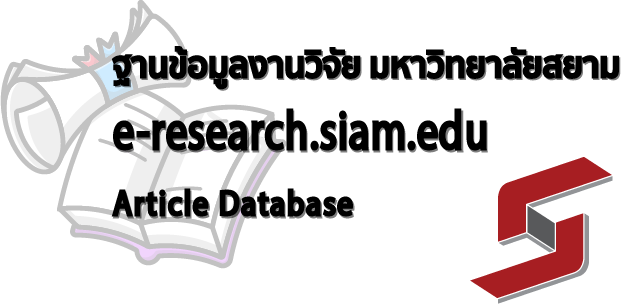- KB Home
- หลักสูตรระดับบัณฑิตศึกษา|Graduate Schools
- หลักสูตรปริญญาโท|Masters Degree
- MBA
- พฤติกรรมการบริโภคอาหารจานด่วนของบุคคลวัยทำงาน เขตจอมทอง จังหวัดกรุงเทพมหานคร
| หัวข้อสารนิพนธ์: Project Title: |
พฤติกรรมการบริโภคอาหารจานด่วนของบุคคลวัยทำงาน เขตจอมทอง จังหวัดกรุงเทพมหานคร Fast food consumption behavior of working people in Chomthong District, Bangkok |
| ชื่อนักศึกษา: Author: |
นางสาว ผกามาศ เชื้อประดิษฐ์ Ms. Phakamas Chuaepradit |
| อาจารย์ที่ปรึกษา: Advisor: |
ดร.รุ่งโรจน์ สงสระบุญ Dr. Rungroje Songsraboon |
| ระดับการศึกษา: Degree: |
บริหารธุรกิจมหาบัณฑิต (บธ.ม.) Master of Business Administration |
| สาขาวิชา: Major: |
การจัดการการตลาด Marketing Management |
| คณะ: Faculty: |
บัณฑิตวิทยาลัย Graduate Schools |
| ปีการศึกษา: Academic year: |
2561 2018 |
การอ้างอิง/citation
ผกามาศ เชื้อประดิษฐ์. (2561). พฤติกรรมการบริโภคอาหารจานด่วนของบุคคลวัยทำงาน เขตจอมทอง จังหวัดกรุงเทพมหานคร. (การค้นคว้าอิสระบริหารธุรกิจมหาบัณฑิต). กรุงเทพฯ: บัณฑิตวิทยาลัย มหาวิทยาลัยสยาม.
บทคัดย่อ
การวิจัยครั้งนี้มีวัตถุประสงค์ 1) เพื่อสำรวจปัจจัยส่วนบุคคลของบุคคลวัยทำงานที่บริโภคอาหารจานด่วน 2) เพื่อศึกษาปัจจัยส่วนประสมทางการตลาดที่มีผลต่อพฤติกรรมการบริโภคอาหารจานด่วน และ 3) เพื่อศึกษาพฤติกรรม การบริโภคอาหารจานด่วนของบุคคลวัยทำงานเขตจอมทองจังหวัดกรุงเทพมหานคร กลุ่มตัวอย่างที่ใช้ในการศึกษาครั้งนี้คือ กลุ่มบุคคลวัยทำงานที่บริโภคอาหารจานด่วน เขตจอมทองจังหวัดกรุงเทพมหานคร จำนวน 400 คน ทำการสุ่มตัวอย่างแบบเจาะจง (Purposive Sampling) และใช้แบบสอบถามเป็นเครื่องมือในการเก็บข้อมูล สถิติที่ใช้ในการวิเคราะห์ข้อมูล ได้แก่ ค่าความถี่ (Frequency) และค่าร้อยละ (Percentage) ใช้ค่าเฉลี่ย (Means) ส่วนเบี่ยงเบนมาตรฐาน (Standard Deviation) สถิติที่ใช้ในการทดสอบสมติฐาน ได้แก่ สถิติไค – สแควร์ (Chi – Square) และการวิเคราะห์ความแปรปรวนทางเดียว (One – way analysis of variance) หรือ F -test และวิเคราะห์เชิงซ้อนด้วยวิธี Least Square Difference–LSD ที่ระดับความเชื่อมั่นร้อยละ 95
ผลการวิจัยพบว่า ผู้บริโภคส่วนใหญ่เป็นเพศหญิง มีอายุระหว่าง 26 – 35 ปี ประกอบอาชีพพนักงานบริษัทเอกชน มีรายได้เฉลี่ย 30,001 – 40,000 บาทต่อเดือน และมีการศึกษาอยู่ในระดับปริญญาตรี ผลการวิเคราะห์ปัจจัยส่วนประสมทางการตลาดพบว่า ด้านช่องทางการจัดจำหน่าย มีความเห็นอยู่ในระดับมากที่สุด และ ในด้านผลิตภัณฑ์ ด้านราคา ด้านการส่งเสริมการตลาด ด้านบุคคลหรือพนักงาน ด้านลักษณะทางกายภาพ และด้านกระบวนการ มีความเห็นอยู่ในระดับมาก และผลการวิเคราะห์พฤติกรรมการบริโภคอาหารจานด่วนพบว่า ส่วนใหญ่เลือกรับประทานอาหารจานด่วน ประเภทอาหารตามสั่ง ความถี่ในการบริโภคอาหารจานด่วนสูงสุด 16 – 20 ครั้งต่อเดือน นิยมใช้บริการร้านอาหารจานด่วนบริเวณชุมชนที่พักอาศัยอยู่ ค่าใช้จ่ายเฉลี่ยในการบริโภคอาหารจานด่วนเป็นจำนวนเงิน 51 – 100 บาทต่อครั้ง และเหตุผลในการบริโภคอาหารจานด่วนพบว่า ร้านอาหารจานด่วน มีการบริการที่รวดเร็ว ทันเวลา ผลการทดสอบสมมติฐานพบว่า ปัจจัยส่วนบุคคล ได้แก่ เพศ อายุ อาชีพ รายได้เฉลี่ยต่อเดือน ระดับการศึกษาที่แตกต่างกันมีผลต่อพฤติกรรมการบริโภคอาหารจานด่วนของบุคคลวัยทำงาน เขตจอมทองจังหวัดกรุงเทพมหานคร แตกต่างกัน อย่างมีนัยสำคัญทางสถิติที่ .05 และปัจจัยส่วนประสมทางการตลาด ด้านผลิตภัณฑ์ ด้านราคา ด้านช่องทางการจัดจำหน่าย ด้านการส่งเสริมการตลาด ด้านบุคคลหรือพนักงาน ด้านลักษณะทางกายภาพ และด้านกระบวนการ มีความสัมพันธ์กับพฤติกรรมการบริโภคอาหารจานด่วนของบุคคลวัยทำงาน เขตจอมทอง จังหวัดกรุงเทพมหานคร อย่างมีนัยสำคัญทางสถิติที่ .05
จากผลการศึกษาในครั้งนี้พบว่า กลุ่มตัวอย่างให้ความสำคัญกับปัจจัยส่วนประสมทางการตลาด ด้านช่องทางการจัดจำหน่าย มากที่สุด ดังนั้น ผู้ที่ประกอบธุรกิจร้านอาหารจานด่วน จะต้องมีการพัฒนากลยุทธ์ และวางแผนการตลาดเพิ่มเติม ด้วยการขยายสาขาธุรกิจ ให้มีทำเลที่ตั้งของร้านขายอาหารจานด่วนอยู่ในแหล่งชุมชนที่เข้าถึงผู้บริโภคได้ง่าย และเพิ่มบริการจัดส่งถึงที่ หรือการพัฒนารูปแบบของบรรจุภัณฑ์ให้นำกลับไปรับประทานที่บ้านได้ เพื่อเพิ่มความสะดวกสบาย และตอบสนองความต้องการของผู้บริโภคได้อย่างตรงจุด จะทำให้ผู้บริโภคประทับใจและเกิดการซื้อซ้ำ เป็นการเพิ่มยอดขาย และเพิ่มอัตราการเติบโตให้กับธุรกิจได้อย่างต่อเนื่อง
คำสำคัญ: อาหารจานด่วน, พฤติกรรมการบริโภค, คนทำงาน
Abstract
The objectives of this study were 1) to explore personal factors of working people who consumed fast food 2) to study marketing mix factors affecting the fast food consumption behavior and 3)to study the fast food consumption behavior of working people in Chomthong District, Bangkok. The sample group used in this study was 400 working people who consumed fast food in Chomthong District, Bangkok. The sampling was purposive sampling and used questionnaires as a tool for data collection. The data was analyzed by frequency, percentage, means and standard deviation. The statistics for testing hypothesis were Chi – square and one – way analysis of variance (ANOVA) by analyzing Least Square Difference (LSD) at 95 percent confidence level.
The results showed that most consumers were female, aged between 26 – 35 years old, working as a private company, an average income of 30,001 – 40,000 Baht per month and having a Bachelor’s degree education. The analysis of marketing mix factors revealed that distribution channels were at the highest opinion level and in terms of product, price, marketing promotion, personnel, physical evidence and process were at the high opinion level. The analysis of fast food consumption behavior showed that most choose to eat fast food by the type of food; the frequency of fast food consumption was up to 16 – 20 times per month; most popular to use fast food restaurants in residential communities; the average expense of fast food consumption was 51 – 100 Baht per time; and the reasons for fast food consumption were fast service and limited break time. Hypothesis testing found that the different personal factors include gender, age, occupation, average monthly income and educational level affecting the different fast food consumption behaviors of working – people in Chomthong District, Bangkok was statistically significant at 0.05 level and the marketing mix factors: product, price, place, promotion, people, physical evidence and process related to fast food consumption behavior of working – people in Chomthong District, Bangkok was statistically significant at 0.05 level.
From the results of this study, it was found that the sample group focused on marketing mix factors in most distribution channels, therefore, people who would like to operate fast food restaurants should develop strategies and additional marketing plan by: 1)expand business branches to have fast food locations in the community where it is easy to reach consumers; 2) adding delivery services or develop a form of packaging to be brought home for convenience; 3) meet the needs of consumers at the right point should impress and promote repeat purchases. These strategies would help to increase sales and the growth rate of fast food restaurants where continuous improvements will provide continuous business.
Keywords: Fast Foods, Consumption Behavior, Working People.
พฤติกรรมการบริโภคอาหารจานด่วนของบุคคลวัยทำงาน เขตจอมทอง จังหวัดกรุงเทพมหานคร / Fast food consumption behavior of working people in Chomthong District, Bangkok
Master in Business Administration (MBA), Siam University, Bangkok, Thailand


